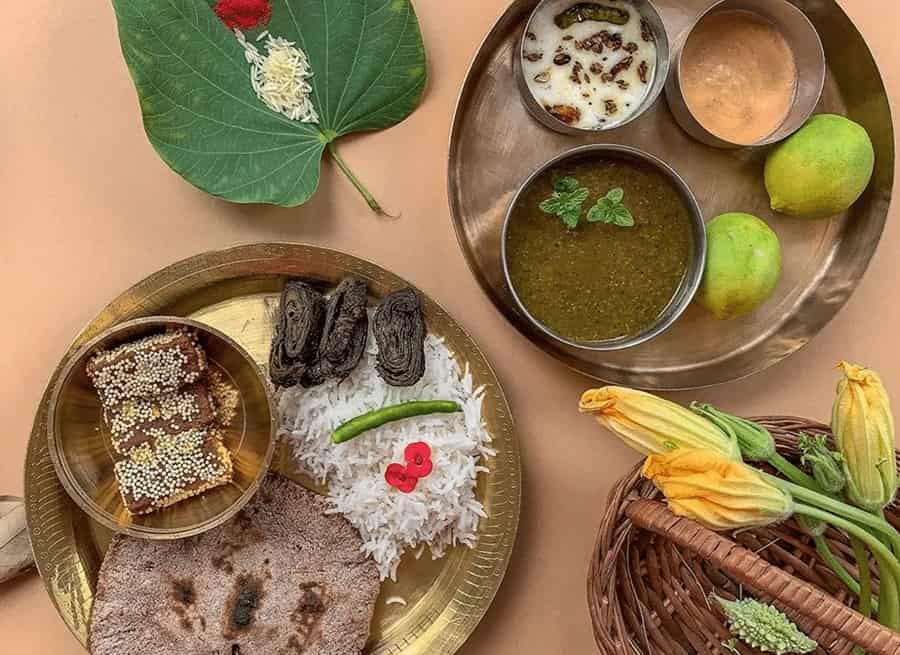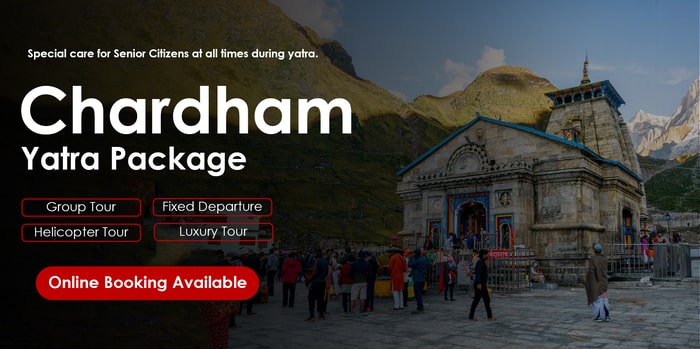Last Updated on December 17, 2025
Badrinath Dham located in the majestic Himalayas is a prominent Hindu pilgrimage destination and one of the sacred Char Dham sites in India. pilgrims travel not only to seek spiritual nourishment but also to indulge in authentic flavors and healthy food options. As pilgrims come from different backgrounds with various dietary preferences and restrictions. Also, digestive discomfort can occasionally arise. In this food guide we will tell you about best places to eat in Badrinath and provide insights into food choices catering to various preferences and restrictions in Badrinath.

Food Scene of Badrinath Dham
There are a variety of food joints across the town offering mouthwatering Garhwali cuisines, which are worth a try. Tourists will also get amazing choices of the dishes native to the particular area which adds up to the variety of culinary discoveries as well. The true essence of Badrinath cuisine lies in discovering its popular restaurants.
Famous Garhwali Dishes in and around Badrinath Dham
- Phaana/Phaanu: These pancakes are made with a mix of lentils (gahat ) which are left to soak overnight. Therefore, lentil paste along with flour is used as a covering for the pancakes and also serves the purpose of forming the spicy and flavorful gravy.
- Kaafuli: Spinach or methi leaves are boiled, mashed and cooked with a mixture of spices and rice powder to infuse unique flavor and health benefits.
- Thechwani: Different Pahadi radish tops or potatoes are crushed rather than sliced, then deep fried with special spices like garlic, cumin, and coriander, thus giving the dish a different flavor taste from the standard.
- Baadi: Baadi, a typical recipe which often served along with Phaanu, is made by blending kwada or Choon flour with the hot water before adding the souring ingredient to it, resulting in the distinctive fluid with the tangy flavor.
- Chainsoo/Chaunsu: A roast meat-like food, Chainsoo consist of black lentils (black gram), spices, and cooking powders that are fully put together to become a dish full of magic. The region is also celebrated for its delightful sweet offerings, including: The region is also celebrated for its delightful sweet offerings, including:
- Arsa: Rice grains are soaked, powdered, and kneaded with jaggery juice to prepare a dough, which is deep-fried into small rolls, providing a rich, melt-in-your-mouth sweetness.
- Singori: By adding the creaminess of milk, molded khoya is fried with sugar and then decorated with grated coconut that enhances the taste and makes it extremely yummy.
- Jhangora ki Kheer: It’s a rustic take on the common kheer but uses jhangora (a millet variety) in place of rice, along with an extra touch of nuts to please your palate.
Food choices from another region
With the Garhwali food, Badrinath also has a mixture of dishes of other regions. Two prominent varieties featured on menus include:
- North Indian: Being Uttarakhand state’s northern part, North Indian breakfast, lunch, and dinner options are most commonly served in local restaurants and Dhaba. Samples that include dal Makhani, Sarson ka Saag, Chana Masala, Palak Paneer, and the famous mixed vegetables that are the everyday fare for the NRIs. Aloo puri and parathas are commonly taken for breakfast.
- Chinese: Since it is close to the Indo-Tibet border, restaurants in the area serve cuisines of Chinese and Tibet. Noodles dishes, Manchurian, cheese chilly and fried rice are one of the top choices available for the people who are looking for Chinese flavors.
Scenery of the restaurant plays important role in food tourism which allures people to visit nearby beautiful places such as along the Alaknanda River or among the majestic Himalayan, peaks. After all, isn’t the food that makes the restaurant stand out? Therefore, make sure that you give these best eating spots a try.
Tips for Food Adventures in Badrinath Dham
- It’s worthy to remember that food without meat, eggs and alcohol are permitted in the pilgrimage place of Badrinath Dham.
- If you are on a budget, you can consider dining at the langars, communal offerings at the ashrams and dharmashalas as an option.
- For eating choices, hygiene should be your priority and you should settle for well-known restaurants that are reputed for their special dishes. Hygiene can become a challenge, especially when food is done in open environments.
- Being one of the major cities of Himalayan region, Badrinath is referred to its local foods, which depend greatly on kidney beans, peas, whole grains and herbs and spices, typical to this region. Make sure that you allow for some time to enjoy some of these delicious tastes as you tour the museum.
Best Places to Eat in Badrinath
Saket Restaurant
- A highly recommended and popular cafeteria is Saket restaurant, located close to the main Badrinath temple, the restaurant provides a very beautiful view of the Alaknanda river and spacious, comfortable sitting places. It is highly lauded for its delicious choices including the fluffy parathas, crispy poori bhaji and aloo matar and thus is near the Temple Bridge Road. The restaurant presents a wide variety of dishes from different parts of India like North Indian, South Indian, Udupi, Gujarati, and Chinese.
Brahma Kamal
- Sacred to the Brahman religion, the Alaknanda River nearby Brahma Kamal house is a pure vegetarian restaurant known for its North Indian cuisine. In terms of comfortable seating and quick service, it is not only a pleasant place to enjoy but also a favorite among visitors. There are rice and curried food items on the list. Neighboring the Temple road, the cost of food here lies between 250-300 INR.
Cafe in the Park
- Nestled with Sarovar Portico, Cafe in the Park possesses luxurious interiors and it is the pure vegetarian multi-cuisine restaurant. This restaurant is located only 850 meters from the main temple and provides an extensive food menu to satisfy diverse tastes. Moreover, besides a fast food joint that provides light meals and drinks, the property has a play area for people who are bringing their kids.
Big Daddy
- Narayan Palace Hotel owns the Big Daddy a multi-cuisine in-house restaurant providing a comfortable atmosphere and free Wi-Fi. Situated a mere 750 meters from the Badrinath temple, it offers visitors mesmerizing views of the mountains. It is widely known for its tandoor cuisine but also for the Chinese, Marwari, Continental, South Indian and North Indian dishes, the average cost of eat here is between 300 and 600 INR.
Specific Dietary Requirements while Visiting Badrinath Dham, Here are Some Tips to Help you Ensure Your Needs are met:
- Research ahead of time: Research where are the good eating places in Badrinath and other nearby ones before you head off on a trip. Seek out places like restaurants or even the canteen with vegetarian options or one that sorts out dietary questions that meet your needs.
- Communicate your dietary restrictions: First, ensure to understand your dietary restrictions when dining out. Let the staff at the restaurant know your requirements clearly so that they can arrange accordingly. Maybe they might suggest you substitutes or modify the dishes information to your fitness.
- Choose vegetarian options: As Badrinath Dham is a religious center, therefore, it is likely that meat, eggs, and alcohol will not be offered. This also makes the vegetarian option a safer choice. Many restaurants in the vicinity are vegetarian-focused.
- Visit langars and ashrams: If you are low on budget or like eating in groups, visit langars (community kitchens) or ashrams, where normally meal is vegetarian and provided for free or less money contribution.
- Be cautious with street food: When going out to various places, one should be careful with the street food, especially if they have some dietary issues or were concerned by its hygiene. Stick to well reputed suppliers and get to them to offer you items that are freshly prepared.
- Carry snacks: If you having special dietary preferences or special needs you can carry healthy snacks or backpack-food that you can consume as often as you wish. This can help to make sure that you have the choices, especially in a case where you can’t get your suitable meals.
- Stay hydrated: irrespective of your dietary preferences, drinking enough water, is even more crucial, especially when you are at places like Badrinath, which is at high altitude. Bring along a reusable water bottle and stay hydrated on your tour by taking many sips.
Such precautions will not only help you, but any traveler whose dietary needs may also conflict with the limited food options available in this holy site.
Conclusion
To sum up, a journey to Badrinath Dham is about profound spiritual and cultural encounters, with the added beauty of the Himalayan snowcapped peaks. The pilgrimage site which is looked upon this is a way of religious life, we need to think about dietary approach before visiting the site with making arrangements for the communication of necessary information with the hotel staff. Selecting vegetarian meals, utilization of community kitchens, and carefulness with shop foods are some of the things that can make the experience of a trip a nourishing and enjoyable multifaceted culinary adventure. Hence, adhering to these tips, pilgrims can heal their souls and tingle their taste buds simultaneously, which will inevitably create sweet memories about their visit to Badrinath.
Posted by
Garima Sachdeva is a creative content writer with 4 years of experience, known for her versatile writing style and ability to simplify complex topics. She specializes in SEO-optimized content, blogs, and articles that inform and engage. With a passion for storytelling, Garima brings fresh perspectives to every project she undertakes.




 Call
Call Enquiry
Enquiry